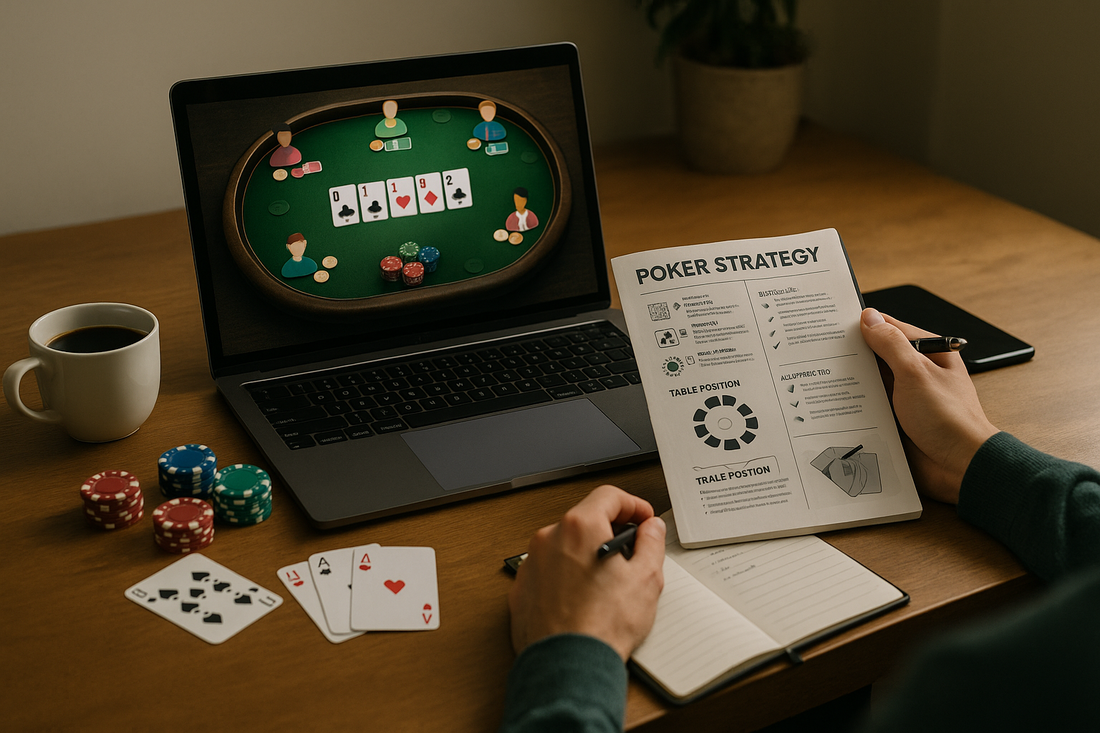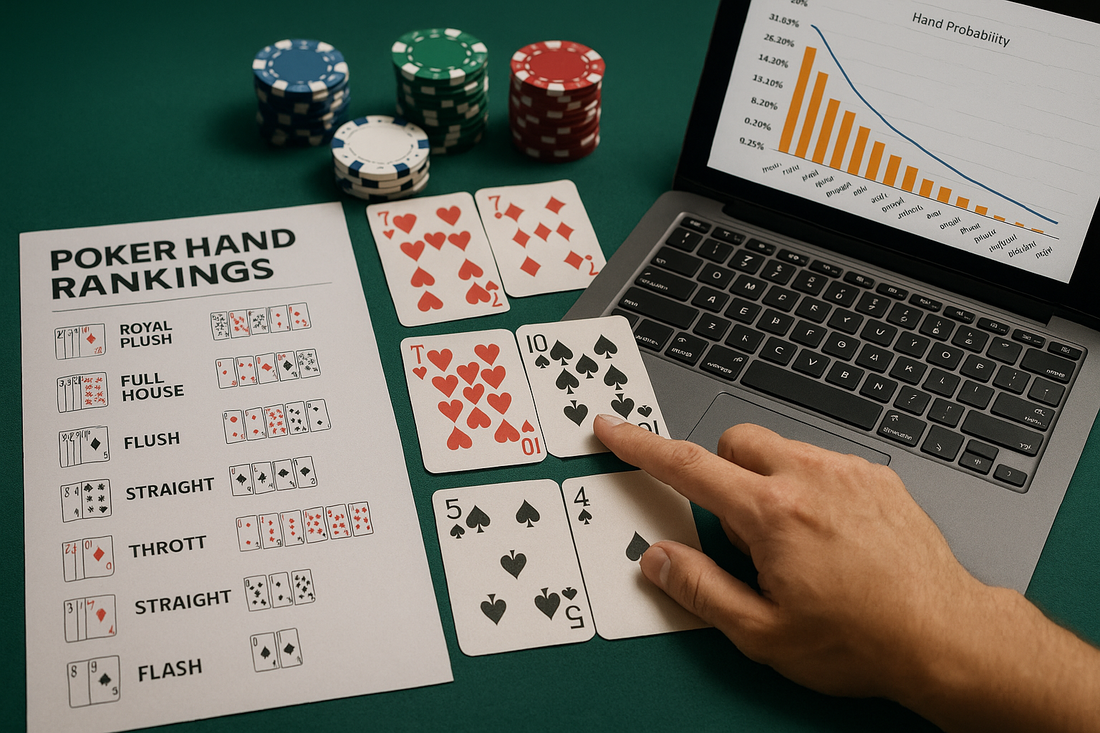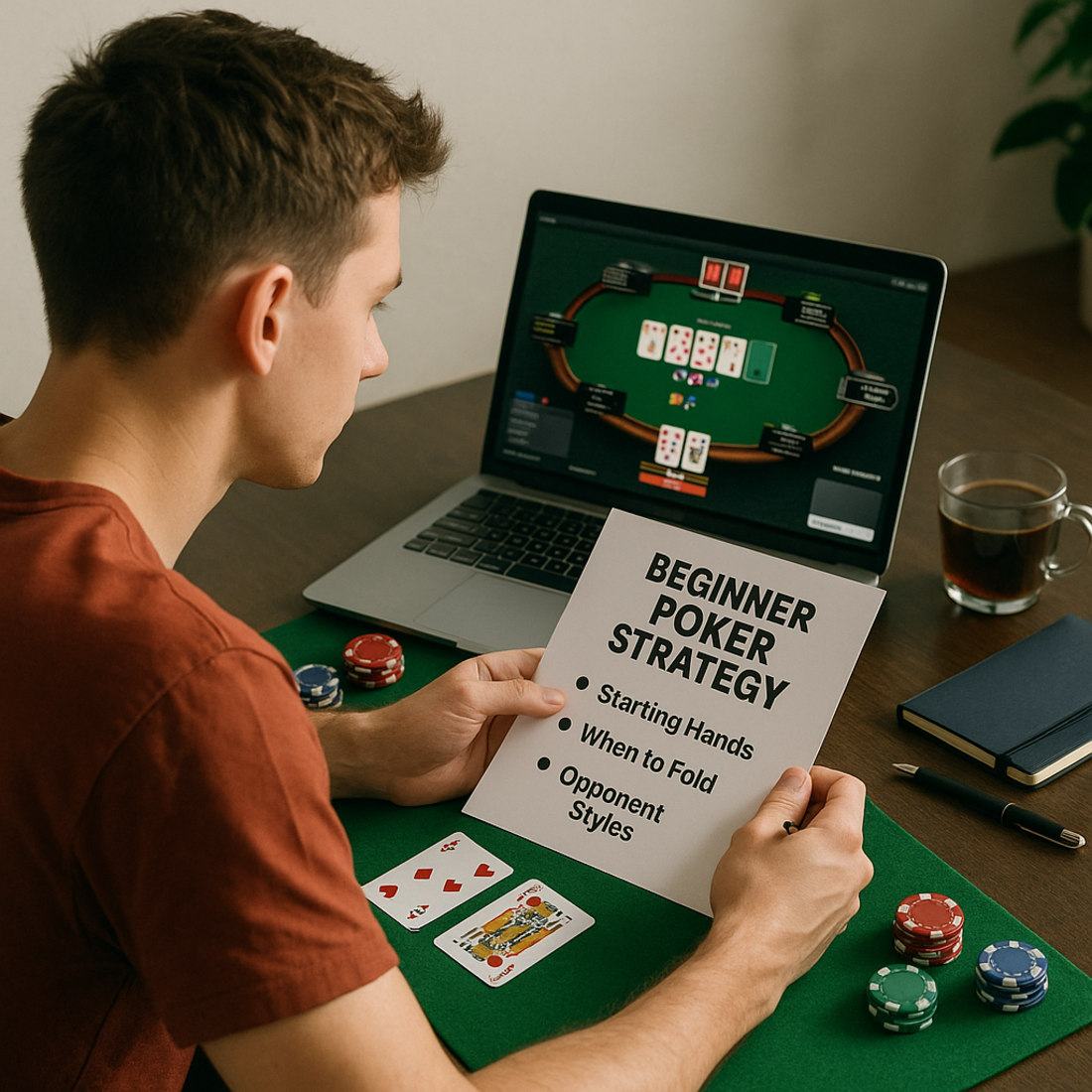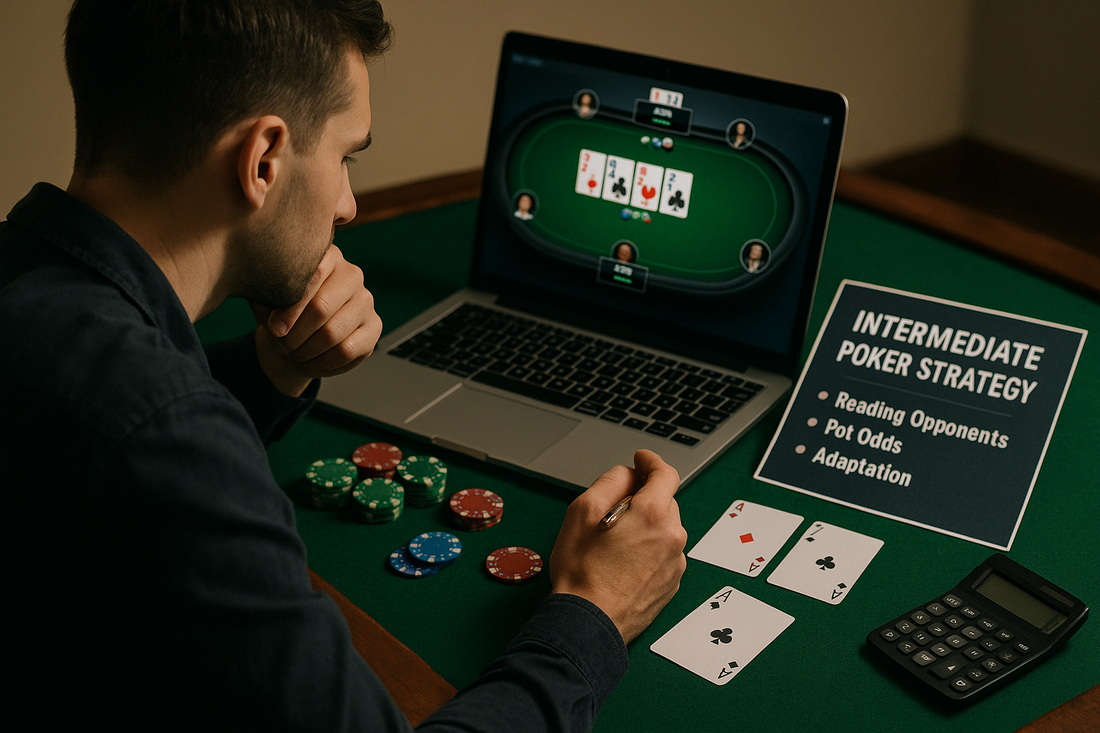If you’re looking to improve your game, understanding poker strategy and card combination is essential. Whether you’re just starting or already know the basics, this guide will walk you through everything — from hand rankings and positions at the table to advanced techniques like bluffing, range reading, game theory, and making decisions under pressure. Let’s dive in and make your play smarter and confident.

Understanding poker basics
Before we dive into advanced strategies and complex concepts, it’s important to understand the fundamentals. Poker basics are what the entire game is built on. This includes understanding which hands are stronger, what table positions are, and the most commonly used terms. Even if you’ve never sat at a poker table, don’t worry – this section will help you get up to speed and feel confident.
Poker hand rankings explained
To feel confident at the poker table, you need to understand how the ranking of combinations works. It’s simple: the less often a combination appears, the stronger it is.
Here is the standard hierarchy of hands from the weakest to the strongest:
- High card – no matches, the highest card plays.
- Pair – two cards of the same rank (for example, two eights).
- Two pairs – for example, two fours and two tens.
- Three of a kind (set) – three cards of the same rank.
- Straight – five consecutive cards of different suits.
- Flush – five cards of the same suit, but not in order.
- Full house – three + pair (for example, three queens and two sixes).
- Four of a kind – four of the same cards.
- Straight flush – five consecutive cards of the same suit.
- Royal flush – the strongest option: 10, J, Q, K, A of the same suit.
It’s not hard to remember this, especially if you play regularly – with practice everything will fall into place!
The importance of position at the table
Position is a key element of strategy. It determines the order in which players make decisions. In early position, you act first and have almost no information, so you need to play carefully. In middle position, you have a little more information, but you still need to be cautious. Late position, especially the button, gives you the greatest advantage: you can see what everyone else is doing and adapt. The later you act, the easier it is to make profitable decisions.
Key terms every player should know
To play comfortably, it is important to understand the basic terms. Blinds are mandatory bets before the hand starts. On your turn, you can fold, call, or raise. All bets form the bank – the “pot” for which there is a fight. Outs are cards that can strengthen your hand. Equity shows the probability of winning based on the current situation. Kicker is an additional card that decides the outcome with equal combinations. These concepts are the basis for understanding the game and making decisions at the table.
Card combinations in poker

If you want to win at poker, you need to not only know what combinations there are, but also understand how often they occur and how to use this information in the game. In this section, we will look at the basic poker hands, their probabilities, and how to interpret the cards on the table to predict what your opponents will do.
High card to royal flush: all poker hands
In each hand, players strive to collect the strongest combination. The weakest is the highest card, when there are no matches. Then there are a pair, two pairs and three of a kind.
A straight is five consecutive cards of different suits, a flush is five cards of the same suit.
A full house combines a three and a pair, a four of a kind is four identical cards.
A straight flush combines the strength of a sequence and one suit.
The rarest and strongest hand is a royal flush: ace, king, queen, jack and ten of the same suit.
Knowing the strength of your hands helps you quickly navigate the game and make accurate decisions.
Probability of each hand combination
Pairs and high cards are the most common hands, and these are the ones you’ll encounter most often. Rarer hands, like flushes, full houses, and quads, are less common, but offer a better chance of winning big. Understanding probabilities helps you assess risks: not to overplay a weak hand or be afraid of pressure when there’s a high chance of a bluff. Experience allows you to intuitively feel how often certain hands appear, and this becomes an important strategic advantage.
How to read the board and opponent’s range
One of the key skills is the ability to read the board and the behavior of opponents. If cards of the same suit appear on the table, someone may be making a flush. If they are in order, it is a potential straight. To understand what your opponent is playing with, it is important to track their actions: whether they raise, how often they bet, how they play in different positions. Based on this, you form their possible range and compare it with the strength of your hand. This allows you to more accurately assess risks and make informed decisions.
Essential poker strategies for beginners

Once you are familiar with the combinations and basics of the game, it is time to start forming your strategy. At this stage, you will first learn to make informed decisions, understand the behavior of your opponents, and choose the right hands to play. In this section, we will look at how to differentiate between playing styles, when to fold and when to attack, and why the choice of starting hand is so important.
Tight vs loose play
All players are divided by style into tight and loose. Tight play is when you enter the hand only with strong hands and play carefully. This approach reduces risks and often works well at the initial level. Loose play, on the contrary, includes a wider range of starting hands and more aggression. In this style, you can take a lot of pots by putting pressure on your opponents, even without having a strong hand.
The main thing is to understand that no style is absolutely correct. Everything depends on the specific situation, opponents and your comfort at the table. At the beginning, it is easier to get used to the tight style, and over time, gradually experiment.
When to fold, call, or raise
This is probably one of the most common questions among beginners: what to do with a particular hand? If you feel that the chances of winning are small, it is better to fold and not get involved in unnecessary struggle. Calling makes sense when you want to see the next card, especially if the stakes are low. But raising is not just a bet, but a signal: “I have a strong hand, and I am ready to play for big money.” Raising is used not only with strong cards, but also as a pressure tool. Therefore, it is important to monitor not only your cards, but also the behavior of your opponents. Often, players hint at the strength of their hand with their actions, especially if they are inexperienced.
Starting hand selection
Learning how to pick your starting hands is one of the most important skills to learn. Not every hand is worth playing. There are hands that are almost always worth playing, like a pair of aces, kings, or AK. And there are cards that are best just thrown away, especially if you’re in early position and can’t see what everyone else is going to do. Late position gives you more freedom to try even weaker hands, especially if you sense your opponents are unsure. The more you play, the more you’ll understand which hands are right for you and in which situations.
Intermediate poker strategies

Once you have a firm grasp of the basics and feel comfortable at the table, it’s time to move on to the next level. This is where poker strategy and card combination become truly important, alongside psychology, math, and adaptability. Here are three essential elements that will help you play smarter and more confidently.
Bluffing and semi-bluffing
Bluffing is a strategic move that aims to make your opponent fold the best hand by demonstrating strength that you don’t have. It is only effective when your betting line looks logical. Semi-bluffing is betting with a hand that is not yet strong but can improve, such as a flush draw. It works doubly: your opponent can immediately give up, and if not, you still have a chance to improve and win at showdown.
Pot odds and expected value
Pot odds are the ratio of the bet to the size of the pot. They are compared to the probability of improving the hand. If the chance of getting the desired card is higher than the cost, it is worth continuing. If not, it is better to fold. Expected value (EV) shows how profitable the decision is in the long run. This is the basis of a mathematically sound game, which helps to make decisions not based on emotions, but on calculations.
Continuation bets and board texture
A continuation bet (c-bet) is a bet after preflop aggression, even if the flop did not improve your hand. It is especially effective on dry boards, where there are few draws and the probability that your opponent missed is high. On wet boards, where flushes and straights can easily be made, you need to be more careful. Analyzing the board texture allows you to understand when it is worth pushing and when it is better to reduce aggression.
Advanced poker techniques

When you already feel confident at the table, understand the positions, calculate the odds and know how to bluff, it’s time to learn more subtle and multi-layered strategies. At this level, it’s important not only to play your cards well, but also to be able to read the game of others, adapt to their style and complicate your own line of behavior.
Range analysis and hand reading
One of the key skills of an advanced player is the ability to analyze the opponent’s range of hands. It’s not about trying to guess a specific hand, but about building a logical picture of all the possible combinations with which he could act the way he does. For example, if a player bets aggressively before the flop and continues to press on the following streets, he either has a strong hand or a well-thought-out bluff. The goal is to eliminate unlikely options, narrow the range and match it with your hand. Over time, this becomes more intuitive.
Balancing your play
If you play too predictably — for example, always betting with a strong hand and checking with a weak one — your opponents will quickly notice this. Balancing is needed to mix up your actions: sometimes bluffing where you usually bet according to strength, and vice versa. This makes the game less readable and protects against attempts to exploit you. At the same time, balance is not chaos, but a conscious alternation of lines and tempo, allowing you to maintain the initiative and confuse your opponents.
Exploitative vs GTO strategy
At the high level of poker, two approaches are actively used: GTO (Game Theory Optimal) and an exploit strategy. GTO is a balanced game without vulnerabilities, which is especially effective against strong opponents.
The exploitative approach, on the contrary, is based on identifying the mistakes of other players and adapting to them: if someone folds often, we bluff more often, if someone does not bluff, we call only with nuts.
In practice, the best result is given by a competent combination of both strategies – GTO as a base and exploitation where it is profitable.
Mastering poker strategy and card combination takes time, focus, and practice. The more you understand the structure of the game, the more confident and effective your decisions become. From simple hands to tough spots, every move gets easier with a solid foundation. Use this guide as a reference, keep refining your skills, and over time you’ll start seeing the game on a whole new level. Good luck at the tables!

